| detail map 2:

|
|
At nr. 73 , at Dariaus ir Gireno gatve, lived
Goras Kaufmanas.
He lived in a wooden house and kept a small shop, where he sold
shirts and cotton. The house doesn´t exist, anymore.
At nr. 72 lived Benjaminas Kacas. Here, one could find the
´monopoly of vodka´.
At 68, next to Benjamin Katz´s house, lived
Joselis Kacas.
He kept a butchery.
Joselis Kacas was married to Liebe. (source: Valerie Koseff,
descendants’gallery)
|
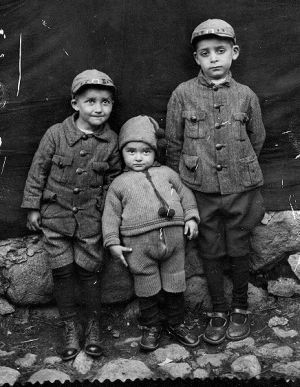 |
mid 1920’s, Pakroy, The Katz boys
|
|
Behind
the house of Joselis Kacas was a property where Rachmilis Klioras
lived. On the map it is nr.69. ( at the right side of the small
street leading to the synagogue). |
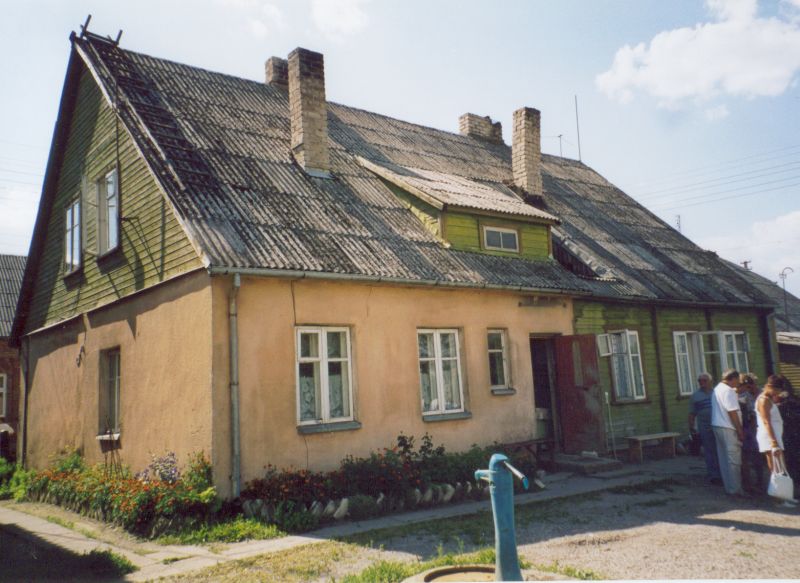 |
house 69
Klioras Rachmilis |
|
Across the small road leading to the synagogue and entrance of the
former “ghetto”of Pakruojis, we see house nr. 66 on
the map. The two brothers Benjamin and Motel lived in this house
which doesn’t exist, anymore.
On the map of 1935 the house is listed under
Zalmanas Grinblotas who lived at no. 55.
Other names, mentioned by people who
lived near the river Kruoja, at the same side as the two brothers,
mentioned above, were Baltius Keklis and
Zydu Bendruonienis. They
lived at 61 and 64.
Their names are not to be found on the map of 1935. Their houses are
gone, just an empty spot near the river. |
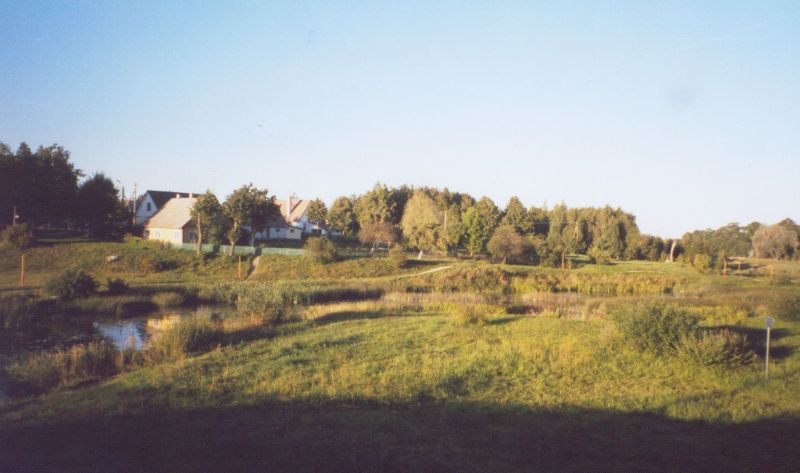 |
houses 61, 64, 65 and 66, now an empty
spot |
 |
id. |
|
In the commentaries is written, that in 1935, house nr. 71 was
under supervision of Va(e)inelis (Vincelis) Rubinsteinas. The
latter lived in the house 65 on the map, across the street, almost
opposite house nr. 71. Also, the young Velve Rubinstein lived in
house nr.65.. He was murdered at the Swedish Hill by the Germans. |
 |
memorial stone on the bank of the river Kruoja
at the Swedish Hill
(with members of the family
Rubensteinas) |
|
I
have to remark, that , in the 1930’s, Hena Lega Ligumer lived in
house nr.71. She rented the house from Frada Sapiriene, Frada
Katz-Shapiro. |
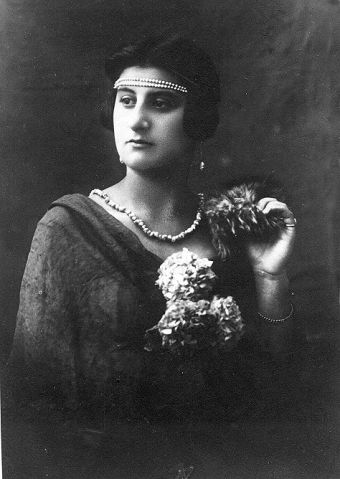 |
A28) late
1920’s, Pakroy, Hena Lega Ligumer |
|
Alongside, at the back of house nr.71, we see a right angle
unmarked, between 71 and 78. This right angle represented the barn
of Frada Sapiriene, the mother of Ruth Shapiro-Igdal and the
grandmother of Frieda Igdal. The barn is still there and we took
some photos. |
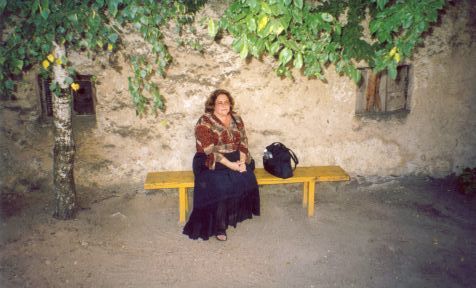 |
Frieda at the original barn in 2003. |
|
At nr. 78 lived Frada Sapiriene and her family. Unfortunately, the
house/ hotel doesn’t exist anymore. Something else was built on this
spot. In her hotel, Frada had a billiard table, a novelty in those
days. The question arises: What destiny the billiard table got after
the war? Is it still somewhere in Pakruojis? Or elsewhere? That’s
what people are talking about...
Frada had always a lot of guests and she even had a paying customer
(a pupil) for a very long period. |
 |
Frada Shapiro's
Hotel Europa |
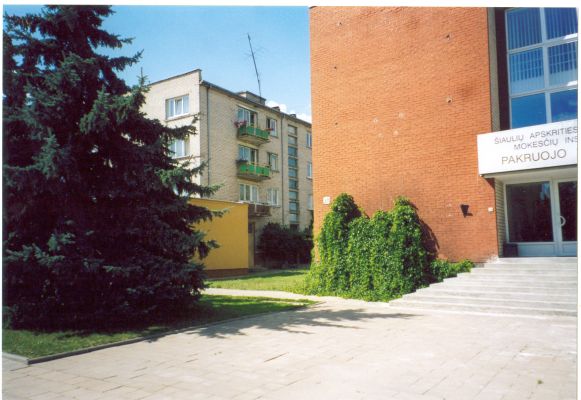 |
spot of house 76(starting from
the red wall to the left); which belonged to
Armonas Firdas.
He rented the house to two Jewish families first
Katz and then Fogel.
house 78 (starting from the stairs to the right);
Šapinienė Frida
(= Frada Shapiro) |
|
We are back now at the Vytauto gatve and we pass house nr. 78. We
encounter house nr. 76 on the map. Firdas Armonas rented this house
to the families: Katz and Fogel. |
 |
A57) 1938, Pakroy
Fogel Child |
|
We continue our walk on the map and house nr. 75 appears, owned by
a non- Jewish citizen of Pakruojis. Two Jewish families lived
in this house:
Har Beryl
and Balser.
Har Beryl kept a grocery. |
 |
A23) 1925, Pakroy
Sotcha Balser-Rudnik. |
|
Some years later
Berta
Gegeckiene (Zenonas' mother) lived in house nr.75, where she kept a
restaurant called Ramjunas, a well-known restaurant, as I heard. |
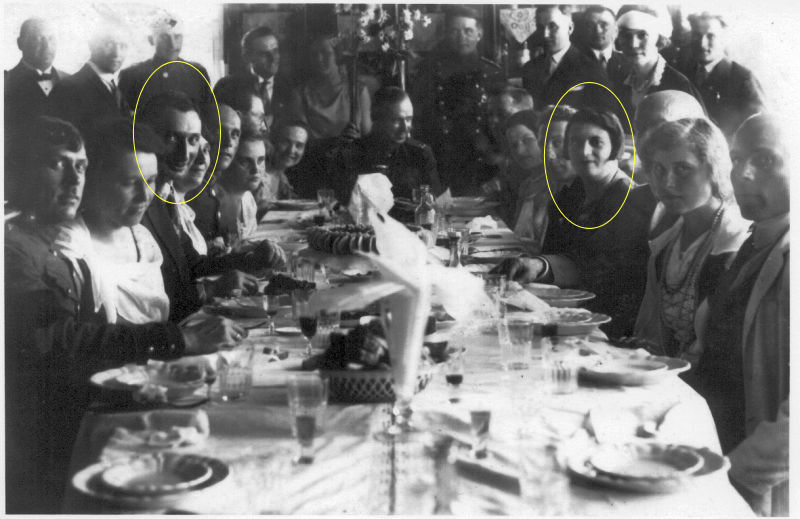 |
This photo was
taken in Berta Gegeckienes’ restaurant in Pakruojis before the war.
In the middle is the mayor
of Pakruojis, at the left doctor Sreiberis, opposite of him Mrs Sreiberis, his wife
(encircled)
|
|
At the beginning of
the war, one of Berta's sons, Antanas, was killed by the Germans.
Antanas was a member of the Komsomol and together with other
Komsomol members, he was shot by the Germans on their forced way
from Pakruojis to Siauliai. His body hasn’t been found till today. |
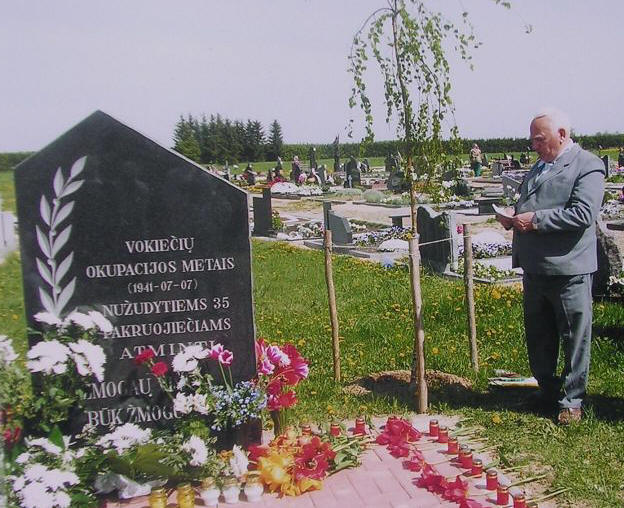 |
Monument, erected 3 December 2007,
commemorating Antanas Gegeckas and the others who were killed by the
Germans. On the picture: Antanas'
brother Zenonas |
|
During the time of the massacre in the summer of 1941, Berta
Gegeckiene , already, didn’t live anymore in house nr. 75. She had
moved to “New Pakruojis”. After the war, Berta Gegeckiene
testimonied as an important witness of the massacre at
Morkakalnis.
Finally, the house on the corner, next to house nr.75, was house
nr. 74; it belonged to Jenkelis Majus.
Now, this all is an empty spot.
We turn back and pass Frada's house and turn to the left. On our
right we see houses 80, 82 and S. |
 |
house S= former bakery of
Rabinovitsj |
|
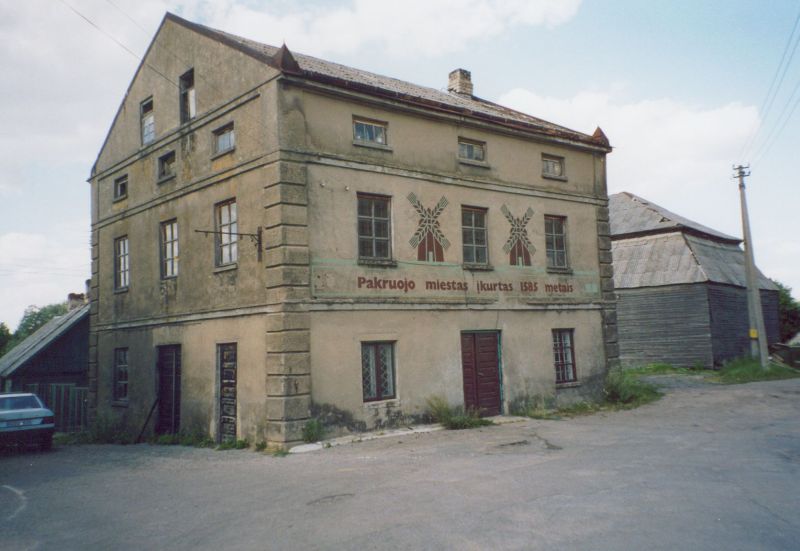
|
id |
|
S
is the Storage building belonging to the families Rabinovitsj, house
nr. 80, Danisjevskij, and
Kaplan, house nr. 116.
Kaplan and Danisjevskij were brothers-in-law.
The families Kaplan and Kolitzman , house nr. 121, were transported
to Siberia by the Russians, just one week before the Germans
occupied Lithuania. It saved their lives. The families Kaplan and
Kolitzman emigrated to Israel at the end of the eighties, at the
beginning of the nineties. |
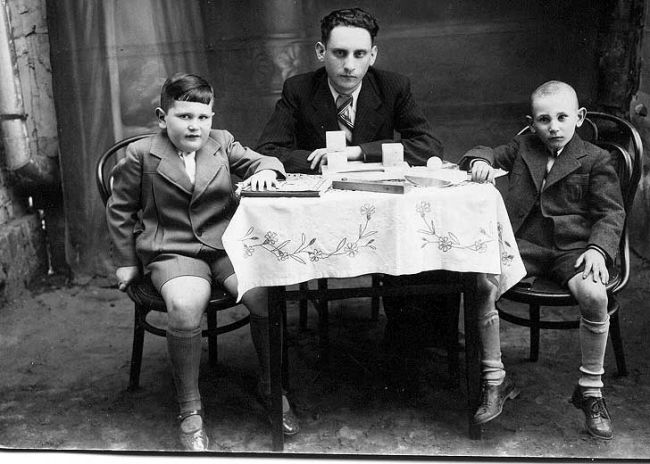 |
A63) 1938,
Pakroy, Teacher Ritov with his students Moishe Klevanski and
Yossel Kaplan |
|
Rabinovitsj and Danisjevskij and Kaplan had the idea of having built
a mill for producing electricity, but because of the war, they
couldn’t make their dream come true.
Between the Storage and the house of Rabinovitsj is house nr. 82 to
be seen on the map. It belonged to Ita Kaciene.
In house nr. 80 at
Vytauto gatve, lived Chaimas Rabinovicius. The family consisted of:
Rabbi Chaim Rabinovitsj, (non-practicing), his wife
Rochel Leah,
their daughters Nechama and
Sora (Nechamka and Sorka), their son
Yitzhak Yankel (It-zi-kle). |
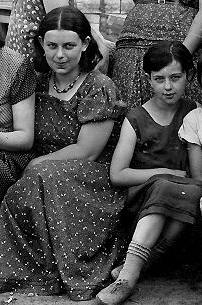 |
1930’s, Pakroy,
Nechama Rabinowitz, Soraleh
Rabinowitz |